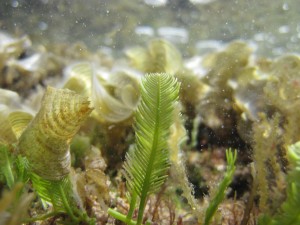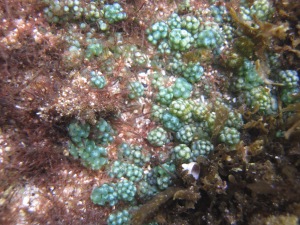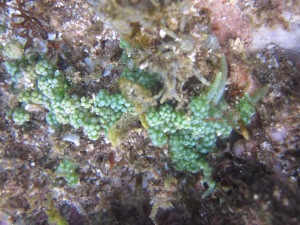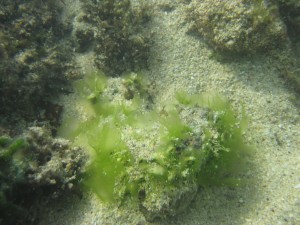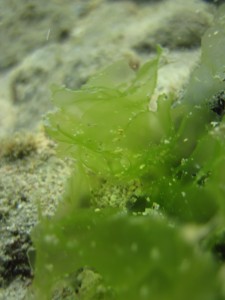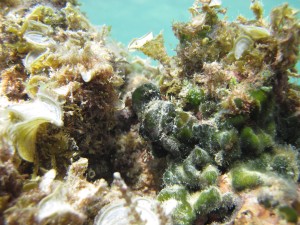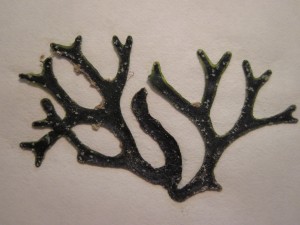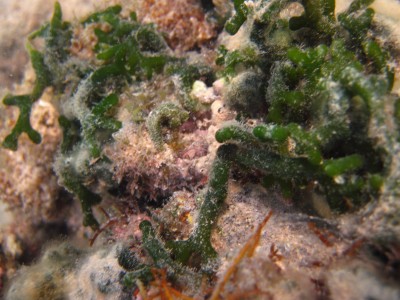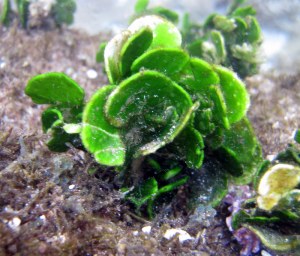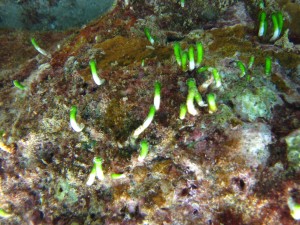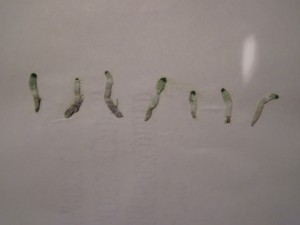Unlike the brown and red algae, only about 10% of all species of Chlorophyta are marine, the rest being found in freshwater ecosystems. More than 100 species of the Division Chlorophyta, green algae, can be found in the Hawaiian Islands. Most are attached to substrates in the intertidal zone with only a few being found in deep-water. Some are membranous, some filamentous and tufted and all show some variation of green color ranging from a light grass green to dark green. An interesting fact about this division is that it is thought that a class of the green algae gave rise to the land plants. There are also many fertilizers that are composed of composted green limu.
Caulerpa spp
There are 13 species of Caulerpa in Hawaii and many are quite commonly found at most sites.
Caulerpa sertularioides
There is very little information recorded about this species. It is native to Hawai’i and is quite common throughout the world. This species ranges from shallow tide pools to the subtidal zone found on rocks and sandy bottoms. It anchors to the substrate using creeping rhizoids (can be seen in the bottom 2 pictures of pressed C. sertularioides) It is commonly mistaken for Caulerpa taxifolia, which is considered invasive in many places around the world, but not in Hawai’i. As of now it is only known to be found on the Islands of O’ahu and Kaua’i as well as some locations in the Northwestern Hawaiian Islands. C. sertularioides is generalized by cylindrical branchlets that give it a feathery appearance.
Caulerpa racemosa
This native species can be found intertwined in mats in tidepools and on reef flats in areas of calm to moderately heavy surf. They resemble small bunches of grapes with their cylindrical branchlets and light to bright green color.
Dictyosphaeria spp
There are two species of Dictyosphaeria that are found in Hawaii. Both are common on reef flats where it grows on rocks and between coral fingers. The only difference between the two species is that Dictyosphaeria versluysii is often a greyish green color and often remains solid, while Dictyosphaeria cavernosa is a bright green and often opens up to a cup shape.
Dictyosphaeria cavernosa
This species is bright green and hollow and eventually opens out and becomes cup-shaped. It is commonly found on reef flats and the shallow subtidal. It is often considered a nuisance seaweed because of its ability to explode in population in high nutrient conditions.
Microdictyon spp
There are two species found in Hawaii. The plants of this species are flattened fronds in which have an almost net-like appearance to their structure. Microdictyon setchellianum is commonly found on reef flats and the mid subtidal region and has a coarse mesh. This will be the most common type encountered since the other species, Microdictyon umbilicatum, is more commonly seen in deep waters (to 60 meters) in the Northwestern Hawaiian Islands.
Ulva spp
The genus Ulva has a worldwide distribution and is one of the better known algae found on reefs. It is characterized by a membranous thallus that is two cells thick, with some plants forming tubular branches. There are about 12 species found in Hawai’i and most are found in areas where water quality is poor.
Ulva fasciata
This is one of the more common algal species found in Hawaiian waters. It is often the dominant species in the intertidal and shallow subtidal regions and is more commonly seen in areas of fresh water runoff high in nutrients such as near mouths of streams and run-off pipes. It has a thin, sheet-like thallus consisting of wide blades, some blades being up to 15 centimeters wide. It is often referred to as sea lettuce because of its distinct sheet-like appearance. They are opportunistic in settlement and are often one of the first species to colonize bare space on the reef. Because of their ecological success, they are considered potentially invasive, and sometimes dominate areas of high nutrients. To Hawaiians it is known as limu palahalaha and is used in a variety of food preparations. Legend also tells of a shark’s ancestor being wrapped in this limu and placed in the sea. For this reason it is believed to be sacred to the shark god and those whose ‘aumakua (personal god) is the shark are forbidden to use it.
(Top right photo credited to Heather Hillard)
Codium spp
Codium can be found worldwide in both tropical and temperate seas. The species in this genus can show a wide range of shapes and sizes with some forming mats along rocks and other growing prostrate and branching. There are 15 species that are recorded for Hawaiian waters.
Codium edule
This is one of the most common species of found on Hawaiian reefs. It is characterized by being irregularly to dichotomously branched and forms mats on reef flats This species is very common in the Waikiki area on Oahu. It is also called was a common algae used for food by Hawaiians.
Halimeda spp
There are seven species of Halimeda found in the Hawaiian Islands, with the most common being Halimeda discoidea. These plants can be erect or having sprawling branches. All species have segmented, calcified branches, with the segments being flattened in most species. Halimeda precipitates calcium carbonate from sea water which forms a hard internal skeleton like structure within the thallus. When the plant dies, the calcium carbonate becomes sand. Because of this unique characteristic, the beaches on the Lisianaki Island in the Northwestern Hawaiian Islands are made almost entirely out of sand from dead Halimeda plants.
Halimeda discoidea
This is an upright species with a small hold fast and broad, flattened segments. This is the most commonly seen species of Halimeda in Hawai’i. It grows on reef flats attached to coral or rock.
Avrainvillea amadelpha
Despite the genus Avrainvillea being widely distributed in tropical seas, Hawai’i only has one representative in the species Avrainvillea amapelpha (also known as “mud weed”). This species is characterized by being spongy, blade-like plants with intertwined filaments. They are generally fan-shaped and can appear individually or in beds along the sea floor. They generally grow on rock, coral rubble, or sand bottoms in the subtidal. It can often displace other species around it, creating a monospecific bed. For this reason this species is thought to be highly invasive and was actually introduced to Hawai’i in the early 1980’s. It is also a top target in various alien algae control programs where volunteers help to remove this seaweed from sea bottom.
Neomeris spp
Neomeris plants are generally only a few centimeters tall and are club-shaped and grow in groups making them conspicuous on the reef. The body is normally green near the tips and white near the base do to calcification. There are two species found in Hawaiian waters, Neomeris annulata and Neomeris vanbosseae. To tell these species apart you need to look at the calcification around the reproductive structures (known as the gametangia) at the base of the plant.
Neomeris annulata
This species grows on eroded coral and ranges in depth from the low intertidal to 60 meters. It is distributed widely through the Indian and Pacific Oceans. It is distinguished from Neomeris vanbosseae by the having calcification around the reproductive structures of the plant that look like worm-like rows. In Neomeris vanbosseae this calcification shows discrete spheres around the reproductive structures



